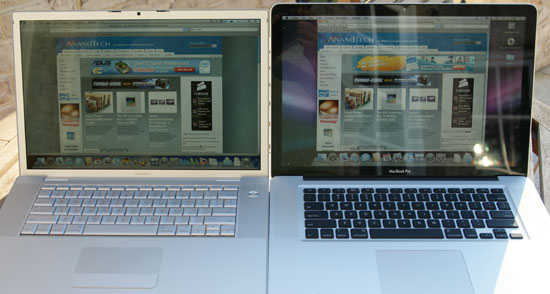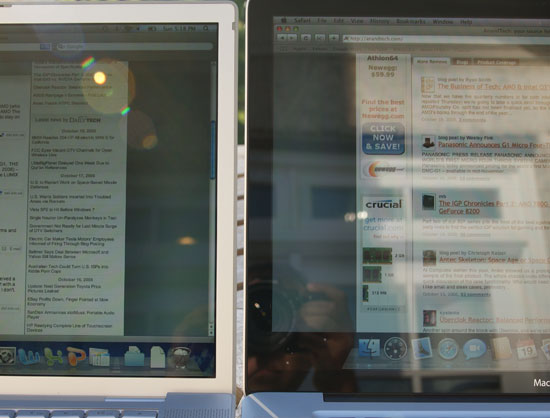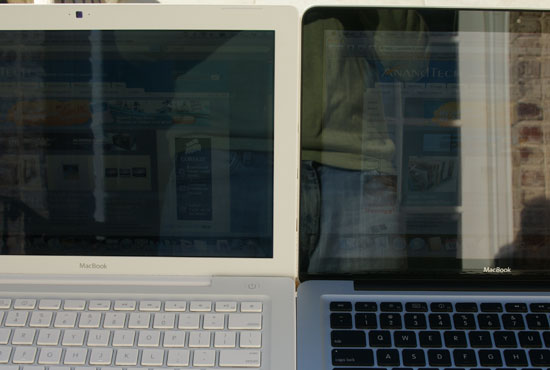Apple's Redesigned MacBook and MacBook Pro: Thoroughly Reviewed
by Anand Lal Shimpi on October 22, 2008 12:00 AM EST- Posted in
- Mac
Oh No, It's Glossy
Glossy screens are in, unfortunately. They look cooler and can improve contrast ratio in normal lighting conditions, but they are extremely reflective. Apple offered a matte option on the previous generation MacBook Pro, but both the base MacBook and the Air came with glossy screens standard. With the new MacBook and MacBook Pro Apple switched to a thin glass covering in front of the display, giving the system a more updated look. I'm not sure functionally if there's any benefit to the glass exterior but it looks cool. Both the MacBook and MacBook Pro have this glass outer layer, although the two notebooks use different physical LCD panels (more on that later).

That's not a mirror baby, it's a display
People have complained about the new glossy screens a lot, but let's see how bad they really are. While the obvious comparison would be between the old and new MacBooks I want to start by comparing the new MacBook to the first generation matte MacBook Pro to put the glossiness into perspective for those of you who don't have a previous generation MacBook:

MacBook Pro matte (left) vs. the new MacBook (right)

MacBook Pro matte (left) vs. the new MacBook (right)
Hello reflections! If you're used to a matte screen, this thing is going to bug the hell out of you. Now let's toss the old MacBook Pro's glossy option into the mix:

The old MacBook Pro matte (left) vs. the old MacBook Pro glossy (right)
The older glossy screen is definitely harder to read outdoors, but indoors (or in the shade) I actually prefer it to the matte screen. Let's look at how the old glossy display compares to the new glass covered glossy one:

The old MacBook Pro glossy (left) vs. the new MacBook Pro on the right (do I even need to call it glossy?)
Reflections-a-plenty on the new display; while the brightness somewhat makes up for it the display is still more distracting than not when outside. I still prefer the glossy displays indoors thus in my opinion the best balance was actually the previous generation MacBook Pro's glossy display. The new one is just a little too nuts - unfortunately you don't really have a choice.
Compared to the previous generation MacBook we have the same problem: the new display is extremely reflective:

MacBook old (left) vs. MacBook new (right)
There are definitely situations where the new displays are unusable outside, especially compared to a notebook with a matte display. Note that these pictures were taken with the sun behind the screens, not in front, so simply turning your torso won't fix these problems. The best solution is to find some shade to work in, or to pick a laptop without a glossy screen. My MacBook Air has a glossy screen that pretty much guarantees writing in direct sunlight is impossible, so I'm used to working in the shade but it is a valid concern.

MacBook old (left) vs. MacBook new (right)
Note that there are also situations where even the older MacBooks aren't usable outside:

Part of the problem is the black border around the display. This part is also covered in glass but it's not backlit, making reflections even more visible there. Compared to the aluminum or plastic border in the previous MBP/MB notebooks, this border looks great but makes reflections seem worse.
I tend to do most of my writing indoors, but if I were still in school and writing on campus the glossy screens would be a definite issue. I saw a quote from Apple saying that the new displays are bright enough to make up for the additional glare; as the pictures above show there are definitely situations where this isn't true.










66 Comments
View All Comments
Calin - Friday, October 24, 2008 - link
What about testing power use under XP I meanXP compares more favourably to Mac OS (or anything else) than Vista, and I wanted to know if that excessive power use is Vista-only, or if it does appear on Windows XP too
strikeback03 - Thursday, October 23, 2008 - link
Or some version of Linux?wilkinb - Wednesday, October 22, 2008 - link
yeh I agree the diff will be how the OS is set to manage each device etc etc...On my Sony laptop i get around 2 hours on high performance and a bit over 5 hours on battery saving...
The results they posted dont really tell us much other then a bootcamp vista install isnt as good as an osx install at managing power on apple laptop... amazing right?
I am sure if i dont use the Sony install and tool/drviers etc I will also get less battery life on my laptop. So the question would be do you think apple put more effort into power management on their OSX install then they did for Vista?
JarredWalton - Wednesday, October 22, 2008 - link
Let me just say that I've tried testing various power saver setting under Vista on several notebooks (see review on Friday) and I just can't get anywhere near 5 hours of battery life. Sure, the CPUs are a bit higher spec on some of the notebooks, but as one example a 12.1" laptop with 55 Whr battery, 320GB 5400RPM HDD, 4GB RAM, LED backlighting, and P8400 pulls an "amazing" 138 minutes of DVD playback and 142 minutes of web surfing... though it does manage 261 minutes when sitting idle at the desktop.As best I can tell, the CPU and HDD just don't seem to be entering sleep modes much if at all, unless the system is 100% idle. Even then, 261 minutes idle battery life doesn't compare favorably to the MacBook pulling 286 minutes of web surfing.
How big is the Sony battery, if I may ask? (Just for reference, take Voltage * mAhr to get Whr.) What sort of CPU, GPU, HDD, RAM does it use? What we need to see to prove it's possible is a Vista laptop with a 20W TDP CPU, 2GB RAM, 5400 RPM HDD, and 13.3" LED backlit LCD that can still get close to five hours of battery life with a 55 Whr battery. If you think you have one, get the manufacturer to send me one for review! :)
Spivonious - Thursday, October 23, 2008 - link
Are you guys turning off the Vista indexer and SuperFetch? Those two things would run the harddrives pretty constantly on a fresh install, which would definitely drag down battery life.JarredWalton - Thursday, October 23, 2008 - link
Do normal users disable SuperFetch? I've disabled indexing as much as I know how, since I don't use it, but SuperFetch is part of Vista. Besides, it shouldn't run on battery power (and neither should indexing).Spivonious - Friday, October 24, 2008 - link
If you want to actually test Vista battery life, install the OS and use it for a week before testing the battery life. I agree with the other poster that both the indexer and SuperFetch are great features, but they do spin the harddrive when the computer is idle until the index is built and SuperFetch learns what you use most often.Spinning harddrive = lower battery life
Comparing battery life between Vista and OS X is like comparing the time it takes to eat a pomegranate and an apple.
headbox - Saturday, October 25, 2008 - link
no, battery tests let people know how long they can use their computer without plugging it in.You're not comprehending the article- the PC laptops are also being tested at idle, just sitting there doing nothing. If Vista is going to spend that entire time "superfetching" nothing, that's a problem.
jonmcc33 - Thursday, October 23, 2008 - link
No, normal users do not disable SuperFetch. That's just bad tweaking advice, as much as turning Indexing off is as well. Both are amazing features added to Vista.I tested a Latitude D630 (2.6GHz Core 2 Duo Penryn, 2GB RAM) with Vista Business and a 9-cell 85WHr battery. Life was over 5 hours.
JarredWalton - Thursday, October 23, 2008 - link
I wouldn't be surprised if there's just some glitch on many of the laptops that's keeping battery life down, but until some manufacturer can deliver Vista with 55 Whr and 5 hours (give or take) battery life I remain skeptical. Users shouldn't have to hack their laptop in any way to get the increased battery life; it should just work properly out of the box. You know, like the MacBooks with OS X.